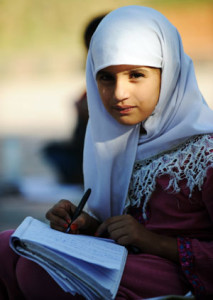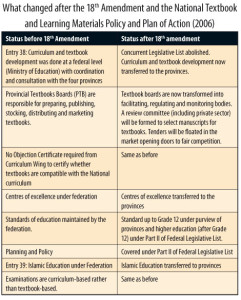Stemming the Rot
By Maheen Bashir | News & Politics | Published 13 years ago
 “Our demand for Pakistan is not for a piece of land. Instead, we want to establish an experimental laboratory where we can practice a system based on Islamic principles.” This (unverifiable) quote is from the public school textbook, Pakistan Studies for Classes IX-X, Sindh Textbook Board Jamshoro (STB), under statements by Quaid-e-Azam Mohammad Ali Jinnah and is read by millions of public-school going children in Sindh everyday.
“Our demand for Pakistan is not for a piece of land. Instead, we want to establish an experimental laboratory where we can practice a system based on Islamic principles.” This (unverifiable) quote is from the public school textbook, Pakistan Studies for Classes IX-X, Sindh Textbook Board Jamshoro (STB), under statements by Quaid-e-Azam Mohammad Ali Jinnah and is read by millions of public-school going children in Sindh everyday.
Further research shows the manner in which the content of this book is politicised. In another chapter, one of the “Causes of the fall of East Pakistan” is listed as the “Role of Hindu Teachers: They produced such literature which created negative thinking in the minds of Bengalis against the people of West Pakistan.” Another reason for the separation of East Pakistan listed in the textbook reads, “International Conspiracies: About 10 million Hindus were living in East Pakistan. India wanted to separate East Pakistan to strengthen the economic position of the Hindus. Many Hindus acted as spies for India…” And it doesn’t end here. The chapter ends with fear-mongering statements such as, “Pakistan is a gift of Almighty Allah. Anti-Pakistan elements are working to damage Pakistan as a country and harm Muslims as a nation.”
It is no wonder then that Anita Ghulam Ali, managing director of the Sindh Education Foundation and former minister for education, has described the standard of public school textbooks in circulation at present as “absolutely rotten.” In fact the quality of education being imparted in government schools is a major source of concern among educationists all over the country.
Ameena Saiyid, managing director of Oxford University Press (OUP), explains that the content of public textbooks is “pathetic.” Says Saiyid, “It is a cut-and-paste job. They [the authors of the books] draw images from the Internet. In fact, they take images from our books.”
For three decades the task of development of a curriculum and textbooks, through an act passed in 1976, was assigned to the federal government. But following the passage of the 18th Amendment and the abolition of the Concurrent Legislative List, this task has been passed on to the provinces (see table).
The devolution of responsibility of textbook development to the provinces is largely seen as a positive step. There were concerns that a national standard of textbooks could be compromised since all provinces will be independently developing their own textbooks. However, Anita Ghulam Ali and Naheed Durrani contend that there are competent people in all four provinces that are quite capable in their field and can handle the task. Furthermore educationists across the board allay concerns that provinces developing textbooks in their regional language will undermine the national language. They maintain that textbooks published in the regional languages may benefit students because children learn and internalise concepts better in their own language, and English and Urdu can always be introduced at higher levels of schooling. The only valid objection is that the budget allocated to each province to deal with the gargantuan task at hand is insufficient.

Ashfaq Yusufzai, in an article for the Inter Press Service, quotes the Chairman of the Khyber Pakhtunkhwa Textbook Board, Dr Fazal-ur-Rahim Marwat, as alleging that, “Pakistan’s educational institutions have been unwitting tools in the spread of militancy in this mainly Muslim country,” attributed to “flawed views that are passed as facts in textbooks.”
I.A. Rehman, director Human Rights Commission of Pakistan, quotes extracts from public textbooks containing religious preachings and out-of-date material in a daily, strengthening the claim that public textbooks are not only substandard but also potentially dangerous. For instance, a “Civics” book for class 9-10 reads, “One merit of the Urdu language is that it upholds Islamic civilisation and culture: therefore, its promotion is one of our important obligations from the religious and national point of view, too.” Another section of the same textbook reads, “Provincialism is a curse that undermines national unity. Some opportunist elements fan provincial and regional affiliations; we should eradicate such trends.”
A passage from “Pakistan Studies” for Classes IX-X (STB), reads: “Islam is the binding force for Muslims. Urdu, which became a common medium of preaching Islam, occupied a unique status.”
Naheed Durrani, former secretary of education, tells Newsline (see interview) that there are also critical deficiencies in public textbooks. “If you pick up a Grade 1 English textbook, it spends eight to nine pages on alphabets and then suddenly skips to sentences. Where are the phonics?” she asks. “Children haven’t learnt vowels and how to develop sounds, or how to connect two letters. In math, they suddenly move from learning digits to two-digit additions!”
Mushtaq Ahmed Shahani, Chairman of the Sindh Textbook Board (STB), however, vociferously denies all such accusations. He maintains: “I don’t know why people say our books are substandard. They are not! I am an educationist and I know they are not low quality. Content is designed according to the curriculum and if we don’t publish the books according to the curriculum guideline, then the federal ministry could reject the books.” Shahani explains that the curriculum has not been revised according to the requirements of the time, be it in the subjects of technology or environment. Meanwhile OUP’s Saiyid contends that “the curriculum is not prescriptive; it just gives you a broad objective and provides you with a lot of flexibility and leeway.” The problem, she feels, lies in the monopoly of textbook boards and describes the Sindh Textbook Board as a “hotbed of intrigue, red tape and bureaucracy.”
As discussed earlier the responsibility for the development of these textbooks for the past three decades lay with the federation, but there was coordination on a regular basis with the textbook boards in all four provinces. The boards would internally choose authors for public textbooks according to their “own whim and liking,” as stated by Naheed Durrani. Authors, says Anita Ghulam Ali, were chosen on the basis of “whether they were the sister-in-law, brother-in-law or friend (of those on the boards) and their generosity was spread over 10-15 people as they got kickbacks from all of them.” After the manuscripts were selected, they were sent to the federation for an NOC on the basis of adhering to curriculum guidelines and were then published and distributed. There were no external review committees or checks and balances in place to ensure a national standard. This process was in place for three decades until The National Textbook and Learning Materials Policy and Plan of Action (2007) took a step in the right direction.
The National Textbook Policy aspires to streamline the process of competitive publishing of textbook through enhanced public-private partnership, break the monopoly of textbooks boards by forming provincial committees represented by the education authorities, textbook boards, and the private sector to select and prescribe textbooks for public schools in each province. This ambitious policy also seeks to introduce a revised national curricula and has been described as a precursor to the 18th Amendment, which has legitimised the purview of the provinces over textbook development and is valid to date. But progress has been painstakingly slow. When Saba Mushtaq, deputy programme manager of the (Sindh) Reform Support Unit, was contacted to determine the progress that Sindh has made, she refused to comment, saying that her superiors had advised her not to.
Saiyid of OUP, however, feels the National Textbook Policy will make little or no progress. In a letter to Ghiasuddin Ahmed, the managing director of the National Book Foundation, she “dissociated herself with the contents of this final draft policy” claiming it was a futile exercise that only served to further strengthen the “monopoly of the textbook boards and the printers/contractors attached to them, lower the standards of textbooks, led to corruption and weakened the education system of the country.” Her bone of contention was that the policy stated, “The textbook boards shall purchase from the publisher whose textbook is selected, a print license for a certain number of copies.”
Says Saiyid, “We submitted dozens of books a year ago, but the Sindh Textbook Board said we would have to hand over the print license. That means I just hand over the copyright to them!” When asked why they wanted the print license, Saiyid explained: “All the profits are in printing and the boards want to maintain the status quo. They choose a third party contractor, who are not printers, and they do a sub-standard job. They don’t care if children are supplied with substandard books. It is stuck in a bureaucratic morass.”
Although the National Textbook Policy (2007) takes a big step forward by outlining a framework for open competition (“inviting private provincial/national publishers to register their intent”), to establish resource centres to improve the quality of books and pledges to increase investment in the department of education, a study of the policy has revealed serious pitfalls. The system is still highly centralised and the Policy (2007) buttresses the textbook boards, which remain the regulating and monitoring bodies that shall “review and help support the process of approval of textbooks in their jurisdiction.” The print licenses remain in their control, effectively disallowing private publishers from publishing public school textbooks. Nepotism is still at large without the appropriate external checks and balances in place. According to Saiyid, examinations are based on public textbooks and not on the curriculum, hence in order to pass, students have to regurgitate the material in public textbooks, effectively making the use of these substandard books compulsory. Book piracy is still rampant and efforts to curb this are missing from the policy.
So will the National Textbook Policy (2007) and the 18th Amendment bring any concrete change to the standard of public textbooks? Documentary filmmaker and educationist, Sharmeen Obaid Chinoy’s tweets are ominous. On June 2, she tweeted, “Would you be surprised to hear that two social studies books I picked up from this year’s government school textbooks have chapters on jihad and they are for 8-10 year olds?” She went on to tweet this month that she has been trying to get the Sindh government to work on textbook reform but the ministry is just not interested. Despite all the policies we draft, progressive as they may be, concrete improvement in the quality of public textbooks is only possible if those in positions of power give up nepotism and corruption as a course of action and look towards opening the field to fair competition before it is too late.
Maheen Bashir Adamjee is an APNS award-winning journalist. She was an editorial assistant at Newsline from 2010-2011.


